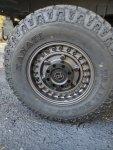I tend to agree with this line of thinking with a stock setup, but this logic is debatable once you add oversized wheels and particularly a non-stock offset. If I were a betting man, I'd say that a properly maintained stock spindle nut setup would probably be fine with the aftermarket wheels/tires, but I seriously doubt anyone has hard data on it. I personally would avoid wheel spacers or non-stock offsets on most all vehicles for lots of reasons. Spindle nut concerns wouldn't be at the top of my list when running non-stock offset, but it would be in my head somewhere (even if I was running the pricey blue ones).
Spacers are a whole other can of worms, bit I do agree.
The difference in offset is approximately 1 inch going from stock 8/12/24 bolts to a -25 offset. That makes a difference, but it’s not huge. Nevertheless, I’m sure it makes a difference over a long enough period of time. Then again, if you’re driving your HMMWV to the grocery store or to pick the kids up from school, that will wear the hubs/spindle/bearings less than taking it off some sweet jumps.
The biggest factor that I see is the weight difference. A factory 150lbs Wheel/Tire/Runflat weighs a hell of a lot more than a forged wheel with a civilian type tire. Given the factory backspacing, 150lbs on a 5” arm is more of a load than 100lbs on a 6” arm.
I’m not trying to be difficult, but I cannot see how such an inconsequential change could lead to any drastic change in life/wear. Anecdotal “evidence” doesn’t hold much water when there are so many other variables. Then again, the “it’s your funeral” crowd doesn’t need logic/evidence/proof.








